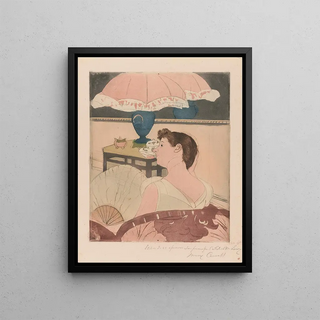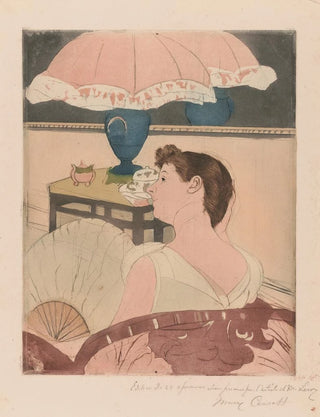Art print | The lamp (Conflict of case) - Mary Cassatt


View from behind

Frame (optional)
In the fascinating world of art, some works manage to transcend time and capture the very essence of the human experience. "The Lamp (Conflict of Cases)" by Mary Cassatt is one of those creations that evokes deep intimacy and extraordinary sensitivity. This piece, both delicate and powerful, invites us to delve into the inner universe of its characters, revealing complex emotions through simple gestures. Cassatt, with her keen eye on the female world, succeeds in creating an atmosphere where light plays a central role, illuminating not only faces but also the thoughts and feelings that inhabit them.
Style and uniqueness of the work
Mary Cassatt's style is distinguished by her ability to combine impressionism with a touch of modernity. In "The Lamp (Conflict of Cases)", the colors are carefully chosen, oscillating between soft shades and striking contrasts. The light, omnipresent, seems to dance across surfaces, creating delicate shadows that add depth to the composition. The characters, although frozen in a moment of tension, are rendered with such finesse that we almost feel their breath. Cassatt excels in depicting women, capturing their strength and vulnerability with rare sensitivity. Every detail, from the draping of clothing to facial expressions, is an invitation to explore the hidden stories behind each gaze.
The artist and her influence
Mary Cassatt, an emblematic figure of the Impressionist movement, managed to establish herself in an art world dominated by men. Born in 1844, she was one of the few women to exhibit alongside the greatest masters of her time. Her friendship with Edgar Degas was instrumental in her development, allowing her to refine her style and explore new techniques. Cassatt has always been fascinated by the female world, highlighting the roles and struggles of women of her era. Her influence endures today, inspiring many contemporary artists who seek to capture the complexity of emotions and human relationships. By choosing to focus on everyday life and intimate interactions, Cass

Matte finish

View from behind

Frame (optional)
In the fascinating world of art, some works manage to transcend time and capture the very essence of the human experience. "The Lamp (Conflict of Cases)" by Mary Cassatt is one of those creations that evokes deep intimacy and extraordinary sensitivity. This piece, both delicate and powerful, invites us to delve into the inner universe of its characters, revealing complex emotions through simple gestures. Cassatt, with her keen eye on the female world, succeeds in creating an atmosphere where light plays a central role, illuminating not only faces but also the thoughts and feelings that inhabit them.
Style and uniqueness of the work
Mary Cassatt's style is distinguished by her ability to combine impressionism with a touch of modernity. In "The Lamp (Conflict of Cases)", the colors are carefully chosen, oscillating between soft shades and striking contrasts. The light, omnipresent, seems to dance across surfaces, creating delicate shadows that add depth to the composition. The characters, although frozen in a moment of tension, are rendered with such finesse that we almost feel their breath. Cassatt excels in depicting women, capturing their strength and vulnerability with rare sensitivity. Every detail, from the draping of clothing to facial expressions, is an invitation to explore the hidden stories behind each gaze.
The artist and her influence
Mary Cassatt, an emblematic figure of the Impressionist movement, managed to establish herself in an art world dominated by men. Born in 1844, she was one of the few women to exhibit alongside the greatest masters of her time. Her friendship with Edgar Degas was instrumental in her development, allowing her to refine her style and explore new techniques. Cassatt has always been fascinated by the female world, highlighting the roles and struggles of women of her era. Her influence endures today, inspiring many contemporary artists who seek to capture the complexity of emotions and human relationships. By choosing to focus on everyday life and intimate interactions, Cass






